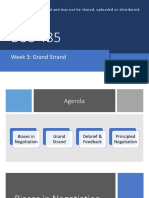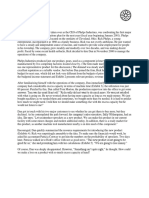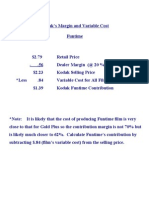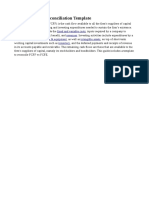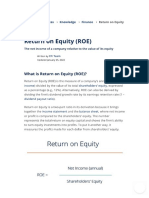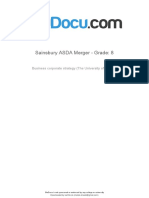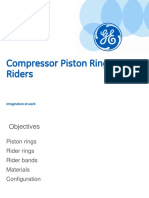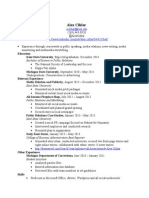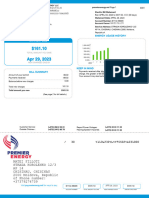Excercise UncertainDemand
Excercise UncertainDemand
Uploaded by
karthik sCopyright:
Excercise UncertainDemand
Excercise UncertainDemand
Uploaded by
karthik sOriginal Description:
Original Title
Copyright
Share this document
Did you find this document useful?
Is this content inappropriate?
Report this DocumentCopyright:
Excercise UncertainDemand
Excercise UncertainDemand
Uploaded by
karthik sCopyright:
lOMoARcPSD|2535112
4. Uncertain Demand - Please give as much additional
information as possible, such as the name of
Operations and Supply Chain Management ( ESCP Business School)
StuDocu is not sponsored or endorsed by any college or university
Downloaded by karthik sk (mailsk.shaadi@gmail.com)
lOMoARcPSD|2535112
Newsvendor
Question 1:
Revenue = $35/unit, Cost = $20/unit and salvage value = $15/unit
Demand distribution
Demand X 100 200 300 400 500 600 700 800
Pr(X) 0.05 0.12 0.15 0.23 0.17 0.15 0.10 0.03
Cum Prob
Part (a): What is the optimal lot size?
Part (b): How many units will be sold on average if we buy the optimal lot size? (Use the table below.)
Y (units sold)
Part c): What is the Expected profit?
Part (d): How many units should you buy if there is no salvage value?
Question 2
A factory makes two products. It has capacity to produce a combined total of 100 units per week, in any
combination. Product 1 costs $20 per unit to make, and sells for $30. Demand for this product exceeds
the factory’s capacity. Product 2 costs $10 per unit to make, and sells for $100, but demand is
uncertain. Product 2 is produced in batches once a week. Any units that are not sold by the end of the
week must be thrown out: they have no salvage value. The average demand for Product 2 is 15 units
with a standard deviation of 5. How many units of Product 2, if any, should be produced?
Question 3
Billy’s Bakery bakes fresh bagels each morning. The daily demand for bagels is a random variable with a
distribution estimated from prior experience given by
Number of Bagels
Sold in One Day Probability
0 .05
5 .10
10 .10
15 .20
20 .25
25 .15
30 .10
35 .05
The bagels cost Billy’s 8 cents to make, and they are sold for 35 cents each. Bagels unsold at the
end of the day are purchased by a nearby charity soup kitchen for 3 cents each.
How many bagels should Billy’s bake at the start of each day? (Choose multiple of 5.)
Question 4
a) Sport Obermeyer sources a particular parka from a supplier in China at a (total landed) cost of
$60. The delivery lead time is 8 months, and therefore Sport Obermeyer needs to source it well
before the selling season. The demand for this item over the selling season is normally
distributed with mean 2000 and standard deviation 600. How many units should Sport
Downloaded by karthik sk (mailsk.shaadi@gmail.com)
lOMoARcPSD|2535112
Obermeyer buy, if it can sell the item for $120 during the regular selling season and at a 60%
discount at the end of the selling season (assuming Sport Obermeyer wants to maximize
expected profits)
b) Sport Obermeyer considers sourcing additional units of this parka from a domestic supplier,
whenever it runs out of parkas during the selling season. This domestic supplier (whom Sport
Obermeyer already used for the prototype production) has very short lead times, and can
produce the items quick enough to fill additional retailer orders during the selling season.
However, it is more costly and charges $80 per parka. How many units should Sport Obermeyer
buy now from the CHINESE supplier? How many units will Sport Obermeyer buy (in
expectation) from the local supplier?
c) By how much do Sport Obermeyer’s expected profits for this parka increase in expectation, if it
sources from the domestic supplier, whenever it runs out of parkas during the selling season?
Question 5
Part 1: The Park Hyatt Philadelphia at the Bellevue has 118 King/Queen rooms. Hyatt offers a rL= $159
(low fare) discount fare for a mid‐week stay targeting leisure travelers. The regular fare is rH= $225 (high
fare) targeting business travelers. Demand for low fare rooms is abundant, while the demand for high
fare rooms is uncertain and follows a Poisson distribution with mean of 27.3 (see below). Assume most
of the high fare (business) demand occurs only within a few days of the actual stay. How many low fare
rooms will you sell?
Part 2: The forecast for the number of customers that do not show up ( X ) follows a Poisson distribution
with mean 8.5. The cost of denying a room to the customer with a confirmed reservation is $350 in ill‐
will and penalties. How many rooms ( Y ) should be overbooked (sold in excess of capacity)? What is the
chance that Hyatt will turn away customers with reservations?
Poisson distribution with mean 27.3: Poisson distribution with mean 8.5:
Q F (Q ) Q F (Q ) Q F (Q ) Q F (Q ) Q F (Q )
10 0.0001 20 0.0920 30 0.7365 0 0.0002 10 0.7634
11 0.0004 21 0.1314 31 0.7927 1 0.0019 11 0.8487
12 0.0009 22 0.1802 32 0.8406 2 0.0093 12 0.9091
13 0.0019 23 0.2381 33 0.8803 3 0.0301 13 0.9486
14 0.0039 24 0.3040 34 0.9121 4 0.0744 14 0.9726
5 0.1496 15 0.9862
15 0.0077 25 0.3760 35 0.9370
16 0.0140 26 0.4516 36 0.9558 6 0.2562 16 0.9934
7 0.3856 17 0.9970
17 0.0242 27 0.5280 37 0.9697
8 0.5231 18 0.9987
18 0.0396 28 0.6025 38 0.9797
9 0.6530 19 0.9995
19 0.0618 29 0.6726 39 0.9867
Continuous Review Problem
Question 6
For a particular product, the demand per week is normally distributed with N( = 150, = 10). Lead‐
time = 4 weeks. The desired service level is 90%.
(a) What should be the value of reorder point ROP?
(b) What is the safety stock?
Downloaded by karthik sk (mailsk.shaadi@gmail.com)
lOMoARcPSD|2535112
Question 7
L = 4 weeks and weekly demand N~[250, 50]. Suppose the company uses a ROP of 1196 units. What
service level is the company providing?
Question 8
A local BP station sells 1,600,000 gallons of regular unleaded gasoline each year and uses a continuous
policy to manage its inventory. It places orders with a fixed order quantity equal to the EOQ quantity,
which is 24,000 gallons. The station’s estimated cost for placing an order is $72; its purchase cost is 91.9
cents a gallon; and its selling price is 106.9 cents a gallon. The costs associated with maintaining a gallon
of gasoline in inventory is annualized at $0.40 / gallon and year. If BP were to run out of gas, it would
lose all sales until its inventory is replenished.
(a) If the following is management’s estimate of lead‐time demand, what is BP’s optimal reorder
point?
Demand (in gallons) Probability
12,000 0.150
14,000 0.600
15,000 0.200
16,000 0.035
18,000 0.010
20,000 0.005
(b) Assume now that both the BP station and its supplier operate 365 days a year. Daily demand is
normally distributed with a standard deviation of 1000 gallons. The lead‐time from supplier to the
station is 3 days. What is BP’s optimal reorder point?
Question 9
Happy Henry’s car dealer sells an imported car called the EX123, and uses a continuous review system.
Happy Henry orders a shipment of new cars on average every 3 months and receives the shipment one
month later. Emergency shipments can be arranged between the regular shipments to re‐supply cars
when inventory falls short of demand. The emergency shipments require two days and buyers are
willing to wait this long for the cars, but without an emergency shipment will generally go elsewhere
before the next regular shipment is due. From experience, it appears that the monthly demand for the
EX123 is normally distributed with a mean of 60 and a variance of 36. The cost of holding an EX123 for
one year is $500. Emergency shipments cost $250 per car over and above normal shipping costs.
a. What ROP should Happy Henry use?
b. Repeat the calculations, assuming that excess demands are back ordered until the next shipment
arrives. Assume a loss‐of‐goodwill cost of $100 for customers having to wait and a cost of $50 per
customer for bookkeeping expenses.
c. Repeat the calculations, assuming that when Happy Henry’s is out of stock of EX123s, the
customer will purchase the car elsewhere. In this case, assume that the cars cost Henry an
average of $10,000 and sell for an average of $13,500. Ignore loss‐of‐goodwill costs for this
calculation.
Question 10
Timbuk2 Inc. manufactures over 100,000 different versions of a messenger bags. Suppose Timbuk2
implements a continuous review model to manage its inventory of a particular plastic buckle. Demand is
approximately normally distributed with a mean of 1000 units per week and a standard deviation of
300. (Each week’s demand is independent of the other weeks.) Since the buckle is sourced abroad, it is
Downloaded by karthik sk (mailsk.shaadi@gmail.com)
lOMoARcPSD|2535112
fairly expensive to order the item ($25 per order), and it takes four weeks to receive the shipment. The
annual holding costs for the buckle are $0.10.
(a) How many should Timbuk2 order and when (at which inventory level) should it order, if its
target service level is 99.5%? [how much not on your final]
(b) When should it order, if it uses instead a target fillrate of 99.5%?
(c) What would be the service level provided, if Timbuk2 would use a ROP of 4000 units instead?
(You may assume that Timbuk2 is operating 50 weeks per year.)
Postponement
Question 11
HEC purchases T‐shirts with the HEC logo from a local manufacturer. These T‐shirts are stocked in three
different colors: red, blue, and green. The annual demand for each of these colors is as follows: RED:
2500 units; BLUE: 5000 units; GREEN: 5000 units. Over the past few years, HEC has observed that while
the average annual demand is given by the figures mentioned above, there is a significant variability in
this demand from week to week. HEC estimates that their weekly demand is (approximately) normally
distributed with a standard deviation as follows:
RED: standard deviation of 20 per week; BLUE: standard deviation of 40 per week;
GREEN: standard deviation of 20 per week.
The cost of each of these T‐shirts is 25 Euros. HEC often needs short‐term loans for their purchases, and
they obtain these short‐term loans from a local bank at an interest rate of 15%. HEC also charges itself
an annual warehousing cost that is 10% of the unit cost of items stored, on top of the financial cost of
inventory.
When placing the order, the manufacturer charges HEC 100 Euros per order, to compensate for the cost
of shipment and processing. The lead‐time of replenishment is 2 weeks. As of now, HEC implements
separate continuous review for each of these three items.
(i) Assuming that HEC operates for 50 weeks a year and wants to store enough T‐shirts to provide a
service level of 99%, find the optimal inventory policy (Q and ROP) for each of the T‐shirts.
(ii) What is HEC’s annual inventory cost for these three T‐shirts, if it implements these separate
continuous review policies?
(iii) HEC is considering the purchase of a “Benetton” machine (at the expense of 15,000 Euros) which
can dye the T‐shirts in‐house in one of the three (and more!) colors that are offered for sale. They
order white T‐shirts with the HEC logo, and then dye the T‐shirts in‐house as customers place their
orders. What are the savings induced by the “Benetton” machine? Explain briefly.
Question 12
Sport Obermeyer decided to use black zippers on most of their ski jackets instead of ordering
customized zippers matching the color of the fabric from Japan. How does Sport Obermeyer benefit
from using standard black zippers rather than customized zippers, if they still have to place their order
well ahead of any demand information for their jackets?
Downloaded by karthik sk (mailsk.shaadi@gmail.com)
lOMoARcPSD|2535112
Question 13
Home Depot is implementing a new ordering system. Historically, each store ordered from the vendors
separately and orders were sent directly to the stores. With the new system, the stores are required to
order from each vendor on a specific day of the week (e.g., every Monday), all orders are consolidated
and labeled for the individual stores by the vendor, and the items are cross‐docked in Philadelphia.
(i) Which inventory model are the stores now required to use?
(ii) What is the main benefit of the new system over the old one?
Question 14
A. In sectors characterized by uncertain demand and long lead times, such as the apparel
industry, investing in tools and techniques to improve market forecasts is the most effective way
to avoid end‐of‐season sales at a discounted price to get rid of excess inventory.
a) Yes.
b) No.
B. Newsboy losses are a serious concern for many firms in the fashion industry. Which one
between the two companies below is more likely to suffer from these losses? Why?
a) Marks & Spencer (traditional clothing retailer)
b) Zara
Solutions
Newsvendor
Question 1:
Demand distribution
Demand X 100 200 300 400 500 600 700 800
Pr(X) 0.05 0.12 0.15 0.23 0.17 0.15 0.10 0.03
Cum Prob 0.05 0.17 0.32 0.55 0.72 0.87 0.97 1.00
(a): SL = (35 ‐ 20) / (35 – 15) = 0.75; Q = 600
(b): Average units sold = 0.05*100+0.12*200+0.15*300+0.23*400+0.17*500+0.28*600=419
Y (units sold) 100 200 300 400 500 600 600 600
(c): Units bought = 600, average sold = 419, average unsold = 181.
Average profit = 419 * (35 – 20) – 181 * (20 – 15) = $5380
(d): Now salvage value = 0, SL = (35‐20) / (35 – 0) = 0.42856; Q = 400
Question 2
Product 1 has a contribution of $10 per unit. Producing one more unit of Product 2 means we produce
one less unit of Product 1, thereby giving up $10. This represents the additional opportunity cost of
producing product 2, above and beyond the usual costs.
Excess cost =10+10=$20 (production cost + opportunity cost of not selling product 1)]
Shortage cost = 90‐10=$80 (lost margin on product 2 – margin made on product 1);
Critical fractile = 0.8 ; z=0.84; Production quantity: 15+0.84*5 = 19.2 => Produce 20 units of product 2.
Downloaded by karthik sk (mailsk.shaadi@gmail.com)
lOMoARcPSD|2535112
Question 3
P = 35 c = 8 v = 3, Cu = 35‐8 = 27 Co = 8‐3 = 5
Critical fractile = 0.84375 => order 25
Question 4
(a) Cu = (120‐60) = 60; Salvage = 0.4 * 120 = 48, Co = (60‐48)=12
Critical fractile =Cu / (Co + Cu) = 60/ (12+60) = 83.33; z = 0.974 (from standard normal table)
Order quantity = 2000 + 0.974 * 600 = 2585
(b) Cu = 80‐60=20; Co unchanged
Critical fractile = Cu / (Co + Cu) = 20 / (12+20) = 62.5; z = 0.319
Order quantity China = 2000 + 0.319*600 = 2192
Exp. order quantity local supplier = expected shortages = L(z) * = 0.2597 * 600 = 155.74
(c) Exp. shortages part (a) = L(z) * = 0.0875 * 600 = 52.5
Exp. sales (a) =exp. demand – exp. shortages = 2000 – 52.5 = 1947.5
Exp. sales part (b) China = 2000 – 155.74 = 1844.26
Exp. leftovers part (a) = batch size – exp. sales = 2585 – 1947.5 = 637.5
Exp. leftovers part (b) = 2192 – 1844.26 = 347.74
Exp. profits (a) = (p exp. sales + v exp. leftovers) – c batch size
= 120*1947.5 + 48*637.5 – 60*2585 = $109,200
Exp. profits (b) = (p exp. sales_C + v exp. leftovers) – c_C batch size + (p – c_l)* exp. sales_l
=120*1844.26 + 48*347.74 – 60*2192 + (120 – 80)*155.74 = $112,712
Increase in exp. profits = $3,512
Question 5:
Part 1:
Cu r r 225 159 66
h l 0.2933
Critical ratio: C C rh 225 225
o u
Hence 24 rooms should be protected for high fare travelers. Similarly, a booking limit of 118‐24 = 94
rooms should be applied to low fare reservations.
Part 2:
Since the demand of high end customers is limited, overbooking results in additional sales of low fare
rooms. Further, since the distribution is given in terms of customers not showing up, underage (and
overage) cost are those of overbooking not enough (too much).
Cu 159
0.3124
Cu Co 350 159
Hence the optimal number of overbooked rooms is Y=7. Hyatt should allow up to 118+7 reservations.
There is about F(6)=25.62% chance that less than 7 customers do not show up, and Hyatt will find itself
turning down travelers with reservations.
Downloaded by karthik sk (mailsk.shaadi@gmail.com)
lOMoARcPSD|2535112
Continuous Review Problem
Question 6
(a) From Normal tables: Z0.90 = 1.29
ROP = L* R + ZSL * (L)* = 4 * 150 + 1.29 * (4)* 10 = 625.8 ~ 626
(b) Safety Stock = ROP ‐ L* R = 626 – 4*150 = 26
Question 7
ROP = mean * L + z* std. dev. * SQRT(L) = 4 * 250 + z * 50 * SQRT (4) = 1196
z = (1196 ‐ 1000)/100 = 1.96. From standard normal table: Service Level = 97.5%
Question 8
(a) D= 1,600,000 gallons/year S= $72 per order h*C= $0.40 per gallon‐year
2 DS
EOQ = Q* = 24,000 gallons [given in revised question]
h *C
Q
Cu= (106.9 ‐ 91.9) cents = $0.15 per gallon Co = h * C * = 0.006
R
CO 0.15
Service level = 0.962
C O CU 0.156
Demand (in gallons) Probability Cum. Prob.
12,000 0.150 0.150
14,000 0.600 0.750
15,000 0.200 0.950
16,000 0.035 0.985
18,000 0.010 0.995
20,000 0.005 1.000
To satisfy Pr(lead time Demand ROP) service level ROP=16,000
Q = 24,000 ROP = 16,000
(b) mean lead‐time demand = (160000/365)*3 = 13150
std dev of lead‐time demand =1000*sqrt(3) = 1732
service level = 0.962 From table, we need to find the z value which corresponds to the 96.2
percentile of the standard Normal Distribution; a table look‐up gives z = 1.78
ROP = mean lead‐time demand + (z * std dev. of lead‐time demand)
= 13150 + (1.78 *1732) = 16232.96
Q = 24,000 ROP= 16,232.96
Question 9
500
a) Cu = 250 Co = = 125
4
250
service level = = 0.6667 from table, Pr (z 0.6667) implies z = 0.44
375
ROP= 60 + 0.44 * 36 62.64 63 => order 63 – on‐hand
Downloaded by karthik sk (mailsk.shaadi@gmail.com)
lOMoARcPSD|2535112
500
(b) Cu = 100 + 50 = 150 Co = 125
4
150
service level 0.5455 Pr( z 0.5455) implies z 0.12
275
ROP = 60 + 0.12 * 6 = 60.72 61 => order 61 – on‐hand
(c) Cu = 13,500 ‐ 10,000 = 3,500; Co = 125
3500
service level 0.9655 Pr(z 0.9655) implies z = 1.82
3500 125
Order‐up‐to level = 60 + 1.82 * 6 = 70.9 71 => order 71 – on‐hand
Question 10
(a) How much to order: EOQ = Sqrt(2*1000*50*25/0.1)=5000
ROP = 1000 * 4 + 2.576 * 300 * Sqrt(4)=5546 (round up!)
(b) Expected shortages per cycle= 0.5%*1000*4 = L(z)*300*2 => L(z) = 0.03333 => z=1.44 => ROP =
4*1000+1.44*300*2=4864
(c) New SL: z=(ROP – 1000*4)/(300*2) = 0; hence the SL=50%
Postponement
Question 11
Part (i) QRed=EOQ=Sqrt(2*2500*100/(25*0.25))=283, QBlue=QGreen=400
ROPRed= 2500/50*2+z*20*Sqrt(2)=166; ROPBlue= 332; ROPGreen=266
Part (ii) Avg Inventory Cost =(Q/2 + safety stock)*H
Inv. CostRed = (283/2+66)* 25*0.25=1296.87; Inv. CostBlue =2075; Inv. CostGreen =1662.5
Total avg inventory cost = 5034.37
Part (iii) You can expect two types of savings over the current system. One comes from the fact that you
are placing now joined orders for all sweaters, so HEC will incur the ordering costs only once for all
sweaters. This should also allow you to lower the (total) order quantity per shipment (i.e.,
Qwhite<QRed+QBlue+QGreen), thereby reducing the cost for cycle inventory. The second savings are due to
risk pooling. Assuming less than perfect correlation in demand, the total demand across all colors is less
variable than the demand for the individual sweaters. Therefore, HEC would need to hold a lower safety
stock to provide the same customer service (i.e., safety stockwhite<safety stockRed+safety stockBlue+safety
stockGreen), thereby reducing the cost for safety stock inventory. [Alternatively, HEC could keep the
safety stock the same and provide a higher customer service.]
Downloaded by karthik sk (mailsk.shaadi@gmail.com)
lOMoARcPSD|2535112
Question 12
Risk pooling => lower safety stock required for the standard zipper rather than customized zippers, and
less shortages. (Possibly also lower unit costs and possible lower transportation costs if it makes local
sourcing possible.)
Question 13
(i) Periodic Review
(ii) Lower transportation cost due to joined shipments
Question 14
A) Answer: b) It is typically extremely difficult and costly to improve forecasts beyond a given level
of accuracy. A better way of dealing with newsboy losses would be to reduce lead‐time (which
reduces uncertainty and implicitly makes forecasting easier and more accurate) or to supply a
continuously renewed set of small batches that never saturate the market, as Zara does.
B) Marks & Spencer. Newsboy losses are a serious concern for companies that – because of their
long lead time ‐ need to forecast demand ahead of time. This is the case for Marks & Spencer,
which have on average much longer lead times than Zara. Alternatively one could argue that
Marks & Spencer operate in a much more stable market than Zara (traditional UK customers as
opposed to young urban shoppers). Hence – in theory – it would be easier for them to predict
demand and to hedge against newsboy losses. This argument is less strong than the first one,
though.
Downloaded by karthik sk (mailsk.shaadi@gmail.com)
You might also like
- Solutions To Sample Exam QuestionsDocument10 pagesSolutions To Sample Exam Questionsrapt100% (2)
- Week 3 Grand StrandDocument36 pagesWeek 3 Grand StrandNoor AroraNo ratings yet
- KLF Electronics QuestionDocument5 pagesKLF Electronics QuestionSumit GuptaNo ratings yet
- Gilbert Lumber Case A11Document7 pagesGilbert Lumber Case A11karthik sNo ratings yet
- Case Discussion Questions:: Calculations - SportsobermeyerDocument3 pagesCase Discussion Questions:: Calculations - SportsobermeyerClaire ZhengNo ratings yet
- Phelps IndustriesDocument6 pagesPhelps Industriesshik1712940% (1)
- Discopress Case SolutionDocument4 pagesDiscopress Case SolutionumarzNo ratings yet
- National Cranberry Cooperative Case SolutionDocument5 pagesNational Cranberry Cooperative Case Solutionhassan ajamiNo ratings yet
- Case3-Obermeyer Case StudyDocument20 pagesCase3-Obermeyer Case StudyAbhilash PatniNo ratings yet
- 8 GMM Comparative Case Study Balonia and BanchuriaDocument16 pages8 GMM Comparative Case Study Balonia and BanchuriaTina WuNo ratings yet
- Kodak Funtime MarginsDocument1 pageKodak Funtime Marginsan052091No ratings yet
- Boston BeerDocument7 pagesBoston BeerAniket Kaushik100% (1)
- Quality Wireless (A) ... KEL153Document6 pagesQuality Wireless (A) ... KEL153Amit Admune0% (1)
- Consolidated DrugsDocument2 pagesConsolidated Drugsgaurav verma100% (1)
- Exercises On News Vendor ModelDocument3 pagesExercises On News Vendor ModelSomesh LohaniNo ratings yet
- De Beers Case StudyDocument30 pagesDe Beers Case StudyHimanshu GulianiNo ratings yet
- FCFF Vs FCFE Reconciliation TemplateDocument5 pagesFCFF Vs FCFE Reconciliation TemplateSangram PandaNo ratings yet
- Os Q1Document18 pagesOs Q1satyam kumarNo ratings yet
- Steel WorksDocument6 pagesSteel Workswenzhuo yang100% (5)
- Krispy Kreme Doughnuts: "It Ain't Just The Doughnuts That Are Glazed!"Document9 pagesKrispy Kreme Doughnuts: "It Ain't Just The Doughnuts That Are Glazed!"dmaia12No ratings yet
- Supply Chain Management: PGP Term Iv Case Study - Wills LifestyleDocument7 pagesSupply Chain Management: PGP Term Iv Case Study - Wills LifestyleagarwalharshalNo ratings yet
- Paramount Case StudyDocument2 pagesParamount Case StudyDipti BhartiNo ratings yet
- Sports Obermeyer WACCDocument10 pagesSports Obermeyer WACCAyesha TahirNo ratings yet
- Zara Case StudyDocument4 pagesZara Case StudyVidarbha ChouhaanNo ratings yet
- Toffee Inc PDFDocument4 pagesToffee Inc PDFDaniel BarrientosNo ratings yet
- SCDP ObermeyerDocument19 pagesSCDP ObermeyergbpiepenburgNo ratings yet
- Merloni Elettrodomestici Spa: The Transit Point ExperimentDocument23 pagesMerloni Elettrodomestici Spa: The Transit Point ExperimenthehehuhuNo ratings yet
- Managing Inventories at Alko Inc.: Case StudyDocument2 pagesManaging Inventories at Alko Inc.: Case StudyDaniel Jadi0% (2)
- O.M Scoott and Sons Case Study HarvardDocument6 pagesO.M Scoott and Sons Case Study Harvardnicole rodríguezNo ratings yet
- Case Study FinalDocument10 pagesCase Study Finalapi-722663626No ratings yet
- 1800flowers Com Company AnalysisDocument21 pages1800flowers Com Company AnalysissyedsubzposhNo ratings yet
- Sport Obermeyer PaperDocument10 pagesSport Obermeyer PaperagarwalankurkNo ratings yet
- CiscoDocument80 pagesCiscoAnonymous fEViTz3v6No ratings yet
- BBC Decision SheetDocument2 pagesBBC Decision Sheetsandeep kumarNo ratings yet
- Steel Works IncDocument12 pagesSteel Works Incsandeep_chanda_2No ratings yet
- Grocery GatewayDocument5 pagesGrocery GatewayPiyush SharmaNo ratings yet
- Le Club Francais CaseDocument8 pagesLe Club Francais CaseTushar GoelNo ratings yet
- Ccbe CASE Presentation: Group 2Document13 pagesCcbe CASE Presentation: Group 2Rakesh SethyNo ratings yet
- Plaza, The Logistics Park of ZaragozaDocument11 pagesPlaza, The Logistics Park of ZaragozaRahulTiwariNo ratings yet
- Assignment 3 - Predicting Consumer Tastes With Big Data at GAPDocument2 pagesAssignment 3 - Predicting Consumer Tastes With Big Data at GAPPRADNYA SHIVSHARANNo ratings yet
- Mcdonald'S Corporation Sustainable Supply Chain ManagementDocument19 pagesMcdonald'S Corporation Sustainable Supply Chain ManagementVasundhora Banerjee100% (1)
- LoeaDocument21 pagesLoeahddankerNo ratings yet
- Solutions Balancing Process Capacity Simulation Challenge 1 and Challange 2Document29 pagesSolutions Balancing Process Capacity Simulation Challenge 1 and Challange 2Mariam AlraeesiNo ratings yet
- Decision Models and Optimization: Sample-Endterm-with SolutionsDocument6 pagesDecision Models and Optimization: Sample-Endterm-with SolutionsYash NyatiNo ratings yet
- Sealed Air Corporation's Leveraged RecapitalizationDocument7 pagesSealed Air Corporation's Leveraged RecapitalizationKumarNo ratings yet
- Group 5 - Diamond Chemicals AssignmentDocument11 pagesGroup 5 - Diamond Chemicals AssignmentRijul AgrawalNo ratings yet
- Question 17: Chapter 2 Inventory Management and Risk PoolingDocument6 pagesQuestion 17: Chapter 2 Inventory Management and Risk PoolingNgan NguyenNo ratings yet
- MaterialDocument5 pagesMaterialmajid aliNo ratings yet
- Logistics of The Leisure Air Problem: Pittsburgh NewarkDocument7 pagesLogistics of The Leisure Air Problem: Pittsburgh NewarkVishal LuthraNo ratings yet
- Cola Wars ContinuedDocument3 pagesCola Wars Continuedichriste106No ratings yet
- Chestnut FoodsDocument2 pagesChestnut FoodsDebanu MahapatraNo ratings yet
- Operation and Product ManagementDocument2 pagesOperation and Product ManagementIbrahim JawedNo ratings yet
- Mondelez Research Note 1Document1 pageMondelez Research Note 1api-249461242No ratings yet
- Barilla SpaDocument3 pagesBarilla SpaMitesh PatelNo ratings yet
- Classic Knitwear and Guardian - A Perfect FitDocument6 pagesClassic Knitwear and Guardian - A Perfect FitSHRUTI100% (1)
- Ford Motor Company: Supply Chain StrategyDocument14 pagesFord Motor Company: Supply Chain StrategyShivani Rahul GuptaNo ratings yet
- 12 Six Basic Strategies PDFDocument6 pages12 Six Basic Strategies PDFAishvarya GuptaNo ratings yet
- Little FieldDocument2 pagesLittle FieldFarah SinnoNo ratings yet
- Sport Obermeyer CaseDocument4 pagesSport Obermeyer CaseNamita DeyNo ratings yet
- Chapter 8 Online Problem Set Revised AnswersDocument6 pagesChapter 8 Online Problem Set Revised AnswersMarian NguyenNo ratings yet
- 2223ProdMgmt HW2 G# T#Document4 pages2223ProdMgmt HW2 G# T#Quỳnh DungNo ratings yet
- Name: - Mansci S43Document3 pagesName: - Mansci S43Ma. Allyssa BuenaventuraNo ratings yet
- Rajesh Exports - May30 - 2023Document7 pagesRajesh Exports - May30 - 2023karthik sNo ratings yet
- WACCDocument7 pagesWACCkarthik sNo ratings yet
- Rajesh ExportsDocument8 pagesRajesh Exportskarthik sNo ratings yet
- Rajesh Exports - Jul7 - 2023Document12 pagesRajesh Exports - Jul7 - 2023karthik sNo ratings yet
- Amrutanjan SR v27 MSDocument13 pagesAmrutanjan SR v27 MSkarthik sNo ratings yet
- Redington Final MSDocument15 pagesRedington Final MSkarthik sNo ratings yet
- Cash Flow From OperationsDocument4 pagesCash Flow From Operationskarthik sNo ratings yet
- Income Statement Operating Profit Margin CalculatorDocument2 pagesIncome Statement Operating Profit Margin Calculatorkarthik sNo ratings yet
- Walk Thru DCFModelDocument5 pagesWalk Thru DCFModelkarthik sNo ratings yet
- The Fake Investment That Connects Byjus and Sri Sri Ravi ShankarDocument5 pagesThe Fake Investment That Connects Byjus and Sri Sri Ravi Shankarkarthik sNo ratings yet
- Operating Profit MarginDocument4 pagesOperating Profit Marginkarthik sNo ratings yet
- Return On Equity - ROEDocument7 pagesReturn On Equity - ROEkarthik sNo ratings yet
- TOI - How RBI - Bring Dollars - Arrest Rupee's SlideDocument5 pagesTOI - How RBI - Bring Dollars - Arrest Rupee's Slidekarthik sNo ratings yet
- TOI - Corporate Foreign Debt Not A WorryDocument5 pagesTOI - Corporate Foreign Debt Not A Worrykarthik sNo ratings yet
- Kumara Gurbhara EnglishDocument2 pagesKumara Gurbhara Englishkarthik sNo ratings yet
- Service Process MatrixDocument5 pagesService Process Matrixkarthik sNo ratings yet
- IIMB Design-ThinkingDocument3 pagesIIMB Design-Thinkingkarthik sNo ratings yet
- Sainsbury Asda Merger Grade 8Document18 pagesSainsbury Asda Merger Grade 8karthik sNo ratings yet
- Et9121 Introduction To Entrepeneurship Student NotesDocument12 pagesEt9121 Introduction To Entrepeneurship Student Noteskarthik sNo ratings yet
- Master Yarn Chart 2014Document9 pagesMaster Yarn Chart 2014johnjkjkNo ratings yet
- Avl SHP Q4 31 03 2023Document18 pagesAvl SHP Q4 31 03 2023jlsinghNo ratings yet
- VOUCHERDocument1 pageVOUCHERYou first MdciNo ratings yet
- Make in India - India's Image Will ChangeDocument6 pagesMake in India - India's Image Will Changeutsavaarohan07No ratings yet
- Developing and Elements: Service Products: Core SupplementaryDocument41 pagesDeveloping and Elements: Service Products: Core SupplementaryPARTH NAIKNo ratings yet
- Intermediate Intermediate: Level: LevelDocument7 pagesIntermediate Intermediate: Level: LevelMarcela MaNo ratings yet
- 09-Compressor Piston Rings & RidersDocument34 pages09-Compressor Piston Rings & RidersUmair A. KhanNo ratings yet
- Module AaDocument37 pagesModule AaAnonymous dUZFpCzLNo ratings yet
- Portfolio Management Progress Exam - AnswerDocument5 pagesPortfolio Management Progress Exam - Answerhoangminh1512No ratings yet
- ASSIGNMENT-2 Business EconomicsDocument4 pagesASSIGNMENT-2 Business EconomicsHareem VekriwalaNo ratings yet
- 105 DR Fixit Powder WaterproofDocument2 pages105 DR Fixit Powder WaterproofJuneNo ratings yet
- GR-72495 FinalDocument6 pagesGR-72495 FinalBaptiste DespresNo ratings yet
- Cprs Payslip1.jspDocument1 pageCprs Payslip1.jspSarthakNo ratings yet
- Alex Cihlar ResumeDocument2 pagesAlex Cihlar Resumeapi-253866734No ratings yet
- Acct Statement XX8926 09022023Document15 pagesAcct Statement XX8926 09022023Tanya RaiNo ratings yet
- TodayoneDocument2 pagesTodayoneramisettyrajesh444No ratings yet
- DANILEICO INTERNATIONAL LLC Electric BillDocument2 pagesDANILEICO INTERNATIONAL LLC Electric Billlucian.danileico94No ratings yet
- Difference Between Simple Interest and Compound InterestDocument3 pagesDifference Between Simple Interest and Compound InterestBeboy TorregosaNo ratings yet
- National Highways Authority of India v. PATEL - KNR (JV)Document11 pagesNational Highways Authority of India v. PATEL - KNR (JV)rayadurgam bharatNo ratings yet
- Metal Gasket Face Seal FittingsDocument12 pagesMetal Gasket Face Seal FittingsSaravana kumar NagarajanNo ratings yet
- Dichtol Sealer Broschure ENDocument12 pagesDichtol Sealer Broschure ENgersom100% (1)
- MET 455 - Quality Engineering and ManagementDocument222 pagesMET 455 - Quality Engineering and ManagementprabhuNo ratings yet
- Little House in The Big WoodsDocument14 pagesLittle House in The Big Woodsgaragebandtutorials2021No ratings yet
- Structure of The Global EconomyDocument17 pagesStructure of The Global EconomySantosh GyawaliNo ratings yet
- CENG 6108 Lesson 1 IntroductionDocument57 pagesCENG 6108 Lesson 1 IntroductionhaileNo ratings yet
- From ToDocument1 pageFrom TobhushNo ratings yet
- Crashing and Cost PlanDocument21 pagesCrashing and Cost PlanRolandNo ratings yet
- Complex Decision MakingDocument20 pagesComplex Decision MakingAreebaNo ratings yet
- 2.1 - Demand Exercises - With SolutionsDocument3 pages2.1 - Demand Exercises - With SolutionsLe Sneaky SnaccNo ratings yet

